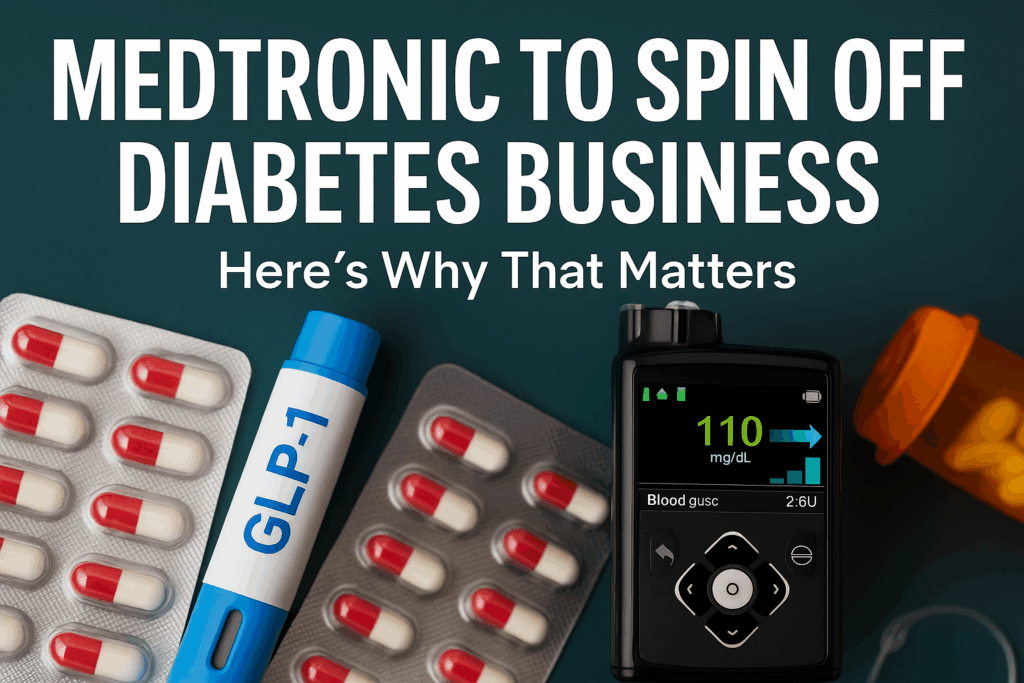The pharmaceutical industry pulls in trillions every year. Not millions. Not billions. Trillions—with a “T.” And among the most profitable segments? Diabetes medication—a booming industry second only to oncology in global pharmaceutical sales. Now, one of the biggest names in medical devices, Medtronic, just threw its hat deeper into the diabetes arena by spinning off its entire diabetes division into a new, public-facing company.
Why would a legacy medical tech firm break up with one of its major divisions? Because they’re playing chess while the rest of the industry’s stuck playing Hungry Hungry Hippos.
🔥 The Diabetes Market Is White Hot

Let’s talk context first. Diabetes meds are no longer just about controlling blood sugar. Thanks to GLP-1 drugs like Ozempic, Wegovy, and Mounjaro, we’ve entered a new era where weight loss, blood pressure regulation, and cardiovascular support are all being tackled by a single shot. That’s one needle to rule them all.
And here’s the kicker: You don’t even need to be diabetic to want in. The weight loss benefits alone have made GLP-1s the “it drug” of modern healthcare. Demand is so high, it’s not just outpacing supply—it’s eating supply for breakfast.
Naturally, Eli Lilly and Novo Nordisk are dominating the scene. They’re the McDonald’s and Starbucks of this game. But when you have insane demand and jaw-dropping margins, the pie gets big enough for more people to want a slice. That’s where Medtronic’s move starts to make sense.
💸 Competition Breeds Innovation (and Capital Needs)

We can’t just talk about demand. You also have to consider the arms race happening behind the scenes. If you’re going to survive in this sector, it’s not just about having a decent product—it’s about continuous innovation, aggressive marketing, and outlasting patent cliffs.
Competition is fierce. GLP-1s may have cracked open the next gold rush, but that means every company in the space now has to spend big to not get lost in the sauce. That includes:
- Improving product efficacy
- Securing exclusive distribution channels
- Getting favorable FDA treatment
- Winning the marketing war on TikTok and morning television
And let’s be honest—Medtronic, as a company, has been a bit… slow-footed in a sprinting match. That’s why spinning off their diabetes business was strategic, not desperate.
🚀 Enter: Medtronic Diabetes (a New IPO Contender)

The newly created entity—Medtronic Diabetes—will be headquartered in Northridge, CA, led by Que Dallara, and will operate as its own publicly traded company within the next 18 months. Translation: they’re gearing up to raise serious IPO capital to compete.
This isn’t just a separation for branding purposes. It’s a structural shift to allow agility, attract investors, and scale like a tech company, not a legacy manufacturer.
Medtronic’s diabetes business is already generating over $2.8 billion annually. So, this isn’t some scrappy startup—they’re coming into the ring with size and resources. But they’ll need more fuel (read: capital) to survive and thrive in a market increasingly dominated by biotech unicorns with Silicon Valley cash.
💊 So What Does This Mean for Patients?

Here’s where it gets interesting: more competition = better outcomes (in theory).
- More companies fighting for market share could drive prices down.
- Innovation might accelerate, leading to better tech integration, like smart pumps, real-time glucose sensors, and more seamless patient monitoring.
- You’ll see increased direct-to-consumer options, which means less reliance on traditional prescriptions and more ownership over personal health.
But let’s not get too optimistic. While we wait for the invisible hand of the market to give consumers a break, prices are likely to remain volatile and trending upward—at least for the next few years.
Before, demand for diabetes medication was largely organic—rising obesity rates, aging populations, etc. Now? Pharma companies are juicing it. Hard. These drugs are on steroids (pun very much intended). We’re seeing marketing blitzes, influencer campaigns, and celebrity endorsements. They’re no longer selling medicine; they’re selling lifestyle makeovers with a co-pay.
🤨 Why I Hate Writing About Pharma

Let’s get real. I hate talking about pharmaceutical companies. Not because they’re boring—because they’re morally murky at best.
Every dollar of profit they earn is a dollar someone paid to stay alive. It’s a business model where suffering is the market opportunity, and life extension becomes a line item.
Yes, innovation matters. Yes, shareholder value matters. But if we’re being honest, capitalism and healthcare are strange bedfellows, and the explosion of GLP-1 meds is proof.
Still, from a business perspective, Medtronic’s move is genius. It’s cleaner. It’s focused. And it positions them to compete in one of the most lucrative pharmaceutical battles of the next decade.
Final Take
Medtronic separating its diabetes business isn’t just a financial maneuver—it’s a strategic realignment to chase gold in a new healthcare frontier. Whether they can compete with the likes of Novo Nordisk and Eli Lilly remains to be seen.
But make no mistake—this spin-off is a signal. The diabetes medication market isn’t just growing. It’s becoming the next Silicon Valley—if your product can lower A1C and melt belly fat, investors will come running.
And Medtronic just opened the door.



